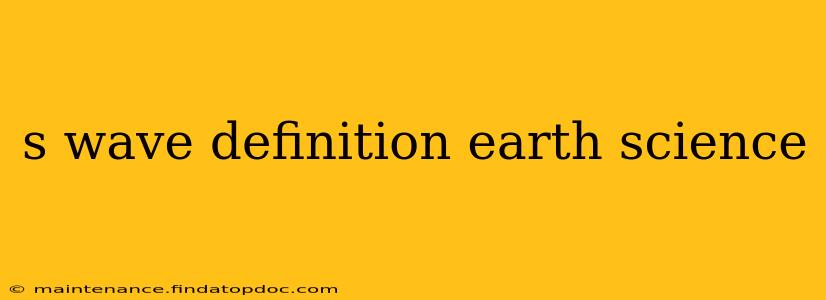S waves, or secondary waves, are a type of seismic wave that travels through the Earth's interior during an earthquake or other significant seismic event. Unlike P waves (primary waves), which are compressional waves, S waves are transverse waves, meaning they move the particles of the medium perpendicular to the direction of wave propagation. This fundamental difference has significant implications for how we understand Earth's structure and the nature of seismic events.
What are S waves and how do they differ from P waves?
The key difference lies in their particle motion. P waves compress and expand the material they travel through, like a sound wave. Imagine squeezing a spring back and forth – that's analogous to a P wave. S waves, however, cause the material to move up and down or side to side, perpendicular to the wave's direction. Think of shaking a rope up and down; the wave travels along the rope, but the rope itself moves perpendicularly.
This difference in particle motion has several important consequences:
- Speed: S waves generally travel slower than P waves through the same material. This is why they are called "secondary" waves – they arrive at seismograph stations after the faster P waves.
- Propagation: S waves cannot travel through liquids or gases. This is because these materials lack the shear strength necessary to support the transverse motion of S waves. This property is crucial for understanding the Earth's internal structure.
- Amplitude: The amplitude, or size, of S waves can be significantly larger than P waves, particularly closer to the earthquake epicenter. This contributes to the destructive power of earthquakes.
How are S waves used to study Earth's interior?
The inability of S waves to travel through liquids provides a powerful tool for studying the Earth's interior. The observation that S waves do not pass through the Earth's outer core was instrumental in determining that the outer core is liquid. This discovery was a major breakthrough in our understanding of Earth's composition and dynamics. By analyzing the speed and path of S waves as they travel through different layers of the Earth, scientists can infer the density, composition, and physical state of these layers. This technique is called seismic tomography and provides valuable insights into plate tectonics and the Earth's dynamic processes.
What is the significance of S wave shadow zones?
The fact that S waves cannot pass through the liquid outer core creates a "shadow zone" on the Earth's surface. This means that seismographs located in certain areas will not detect S waves from a given earthquake, even if they are powerful enough to register elsewhere. Analyzing the size and location of these shadow zones helps geophysicists refine models of the Earth's interior. The absence of S waves in these zones provides strong evidence for the liquid outer core.
How do S waves affect buildings and infrastructure during an earthquake?
S waves, due to their larger amplitude and transverse motion, are often responsible for the significant damage observed during earthquakes. The ground's shaking caused by S waves can cause buildings to sway and collapse, resulting in widespread destruction. The intensity of the shaking depends on several factors, including the magnitude of the earthquake, the distance from the epicenter, and the local geological conditions.
Can S waves be predicted?
Currently, there is no reliable method to predict the arrival time or intensity of S waves during an earthquake. Earthquake prediction remains a significant challenge in seismology. While scientists can model the potential for earthquakes in certain areas, precise prediction of the timing and magnitude remains elusive. However, understanding the characteristics of S waves is crucial for developing earthquake-resistant infrastructure and minimizing the risk to human lives and property.
What is the relationship between S waves and P waves in earthquake studies?
The difference in arrival times between P waves and S waves at seismograph stations provides crucial information about the distance to the earthquake epicenter. The farther away a station is from the epicenter, the greater the time difference between the arrival of the P and S waves. This time difference is used to locate the epicenter using triangulation methods. Analyzing both P and S wave data is essential for comprehensive earthquake analysis.
This comprehensive explanation addresses various aspects of S waves and incorporates potential "People Also Ask" questions, providing a robust and SEO-optimized article.
